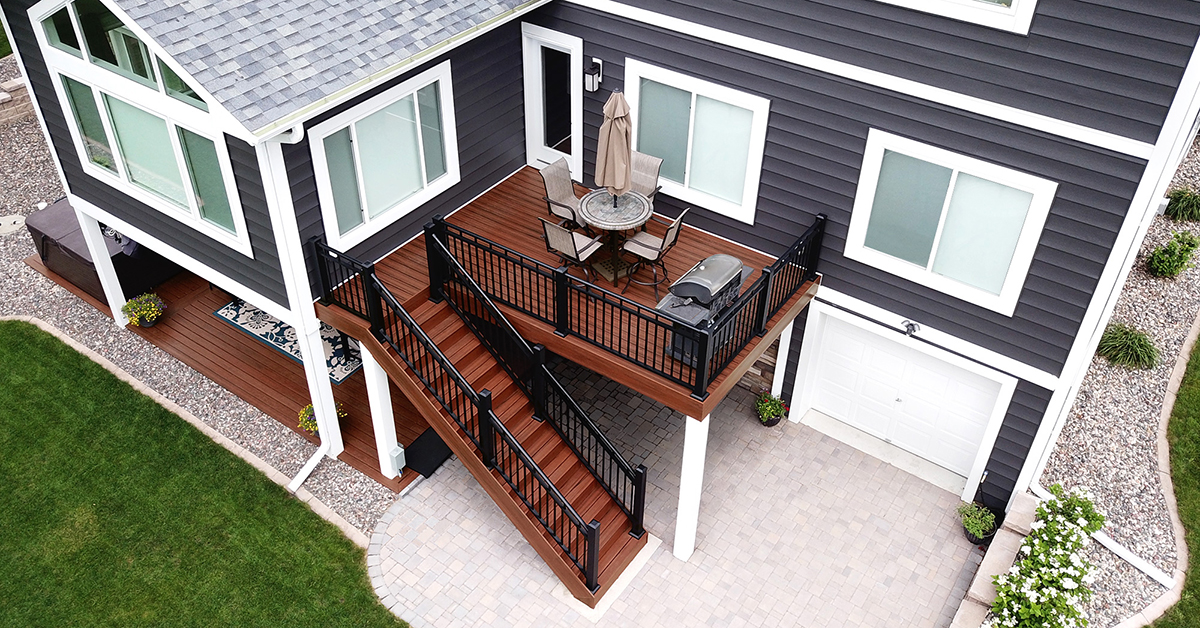
DESIGNED for BEAUTY.
MADE for LIFE.
Blog & News
What Size Should My Deck Be?

A deck can add an exciting new living space to your home. Depending on what your deck will be used for, how much yard you’d like to maintain, etc, the size of your deck is very important. Finding you’ve built too small or too large can be a frustrating revelation after the fact. This is why it is a crucial factor to consider long before beginning the building process.
What is the Average Size of a Deck?
For most builds, decks are wider than they are deep, with the longer portion of the deck running alongside the house. According to landscapingnetwork.com, the average size is between 300 and 400 square feet. Decks can also be multi-level, adding more space and dimension to your home.
If you are considering a multi-level deck but are on a tight budget, don’t worry. It is perfectly normal for homeowners to build the first level, and then add the other tiers when they are better able to afford them. However, it is a good idea to consider these additions when creating the initial design.
Size of Your Home
Most builders suggest that your deck should be no larger than 20 percent of the house’s* square footage. This is so that the deck does not overwhelm a home visually. This, of course, is up to you. If you feel you need a larger deck that takes up more of your yard space, feel free! This may give you less lawn to mow and more yard to enjoy.
Regulations, Codes & Permits
As with most remodeling projects, you’ll need to obtain a permit before you begin building. You’ll also need to check local building codes, regulations and restrictions.
Lot restrictions may limit how close your deck can be to your neighbors’ property, limiting its size and dimensions. The location of a well, septic tank or drain field may also affect how far your deck can extend from your home.
Transitioning
The size of your deck also determines where it will begin and end. If you have a garden or enjoy putting your toes in the grass, you’ll want to choose a size that doesn’t overwhelm your yard. You’ll also want to create a design that blends in with your yard as seamlessly as possible. To accomplish this, first, determine which areas you’d like to maintain. Then, use transitional materials to bridge your deck to these areas. Stones, pavers and bricks are a very popular choice for this step.
What Is The Best Deck Size For Entertaining?
The size of your deck depends greatly on how you plan to entertain. For some, entertaining means having a few people over for a relaxing meal. For others, it can be much more elaborate. Consider these factors before building your deck:
- Will you need a small grill or large kitchen area with refrigerator, sink and counter space?
- Will you be enjoying movies on your deck? If so, how much seating will be needed?
- Will your deck encapsulate a pool? Will you be adding on a pool house?
- Will you need a separate area for a hot tub or showers?
- Will you need multi levels and will you want access from these levels?
For most, the space needed for entertainment is minimal. For instance, if you are only considering a small grilling area and patio set, the space needed to seat 4-6 people requires about 144 square feet. For 10-12 people, you’ll want up to 288 square feet. However, if you want extra breathing room, we recommend at least 392 square feet.
What Shape Should Your Deck Be?
When it comes to decks, shape, and size go hand-in-hand. Meaning, many times, a deck must be shaped to fit into the space available. When you have a lot of space, this is not an issue. However, for those who live in the city, or densely populated areas, creative shaping is a necessary consideration.
For most experienced deck builders, space is something they deal with every day, especially for those builders who work primarily in the city. These builders may choose to follow the lines of your home or ad curves and angles to better fit the shape of your limited space. Many can get very creative by mixing straight and curved lines to your project. This type of plan gives a crisp feel to the straight areas of your deck and a softer appeal where curves are added. Overall this mix of straight and curved lines can add an interesting and aesthetically pleasing look to your home and decking project.
Ready to begin your deck building project?
We can help you find a builder, choose your decking material, determine how many boards you need, and more! Click here to get in touch with us!

